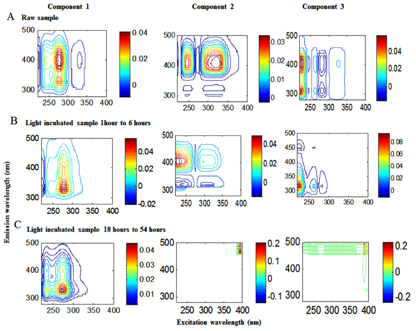This study examined the effect of sunlight on extracellular polymeric substances (EPS) photo-flocculation and transparent exopolymer particles (TEP) formation in experimental observation using conventional chemical and spectroscopic methods. The results demonstrated that EPS upon exposure to sunlight were partially transformed into transparent exopolymer particles (TEP) and unstable flocs of different sizes without the addition of any precursors. EEM-PARAFAC modelling identified humic-like and protein-like or tyrosine-like components in both untreated and irradiated EPS samples (Fig. 1). After 58 hours of solar irradiation, humic-like substances were entirely decomposed, while the regenerated protein-like substance from EPS was the key component in the irradiated samples. Our time-lapse images of the EPS-to-TEP-size transformation showed that TEP/floc formation in aqueous solution is gradually increased from the 0 hour to the 58-hour time points.

Figure 1. Fluorescent components of EEM-PARAFAC identified by three-component analysis for: (A) Raw EPS samples, (B) sunlight irradiated EPS sample from 1 hour to 6 hours and (C) sunlight irradiated EPS sample from 19 hours to 58 hours of exposure.
Proposed mechanisms of photo-flocculation
We suggest that a simultaneous process could link TEP/floc formation to the degradation of EPS (or DOM) in aqueous media, thereby forming complexes between free metals and newly formed DOM that ultimately generate TEP/flocs (Fig. 2). In these mechanism, the initial complex between EPS and metal abbreviated as EPS-M upon light exposure can produce protein-like and humic-like substances and unknown components, any of which are considered to be complexed with metals in the solution (see Eqs 1–2). Therefore, given EPS as autochthonous DOM and its complexations with trace metals (M) abbreviated as EPS-M, the possible detailed mechanistic sequence of TEP/floc formation by sunlight is as follows (Eqs 1–3):
EPS-M + hυ → PLS + HLS + UC + M ……………………………………… (1)
PLS + HLS + UC + M + hυ → PLS-M + HLS-M + UC-M …………..................(2)
PLS-M + HLS-M + UC-M hυ → PLS-M(TEP/floc) + UC-M(TEP/floc) +photoproducts ……………………..(3)
Where, PLS, HLS and UC are the protein-like substances, humic-like substances, unknown components and their complexes with metals are PLS-M, HLS-M and UC-M, respectively. Finally, photo-flocculation and microbial transformation of EPS into TEP/flocs particles could therefore be an important path-way for better understanding of particle formation and sedimentation, as well as recycling of nutrients in the lake and oceanic environments. These results suggest that TEP/floc formation from EPS could occur by a complexation mechanism between dissolved organic matter and metals, thereby causing ionic charge neutralisation upon sunlight exposure.

Figure 2. A conceptual model of TEP/floc formation from raw EPS components.
The main information of this paper: Mashura Shammi, Xiangliang Pan*, Khan M. G. Mostofa*, Daoyong Zhang, Cong-Qiang Liu (2017) Photo-flocculation of microbial mat extracellular polymeric substances and their transformation into transparent exopolymer particles: Chemical and spectroscopic evidences. Scientific Reports 7(1):9074
This work was financially supported by National Natural Science Foundation of China (41203088, 31360027,U1120302, and 21177127). This study was also partly supported by the Tianjin University funding.
The related publication link in that regard is listed below.
Website: https://www.nature.com/articles/s41598-017-09066-8